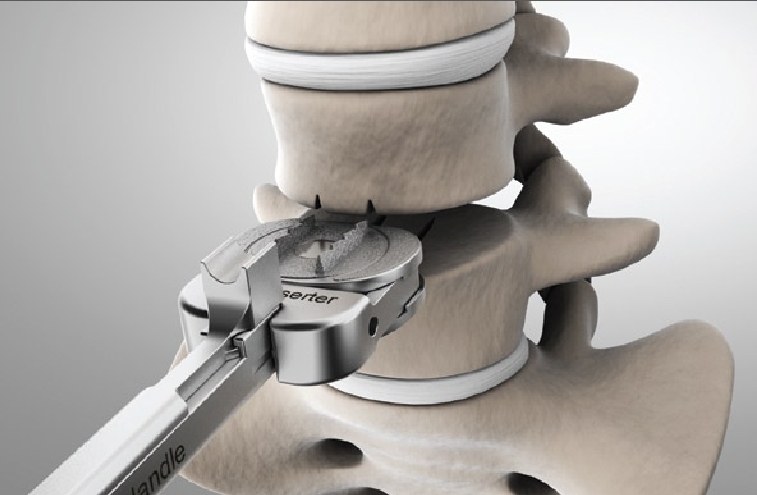. 2021 Sep 21;13(9):e18175.
doi: 10.7759/cureus.18175.
eCollection 2021 Sep.
Affiliations
Affiliations
- 1 Neurosurgery, University of Florida, Gainesville, USA.
- 2 Neurosurgery, University of Florida College of Medicine, Gainesville, USA.
Item in Clipboard
Ken Porche et al.
Cureus.
.
Display options
Format
. 2021 Sep 21;13(9):e18175.
doi: 10.7759/cureus.18175.
eCollection 2021 Sep.
Affiliations
- 1 Neurosurgery, University of Florida, Gainesville, USA.
- 2 Neurosurgery, University of Florida College of Medicine, Gainesville, USA.
Item in Clipboard
Display options
Format
Abstract
Objective Transforaminal lumbar interbody fusion (TLIF) is a common approach and results in varying degrees of lordosis correction. The purpose of this study is to determine preoperative radiographic spinopelvic parameters that predict change in postoperative segmental and lumbar lordosis after TLIF. Materials & Methods This study is a single surgeon retrospective review of one-level and two-level TLIFs from L3-S1. All patients underwent bilateral facetectomies, 10 mm TLIF cage (non-lordotic) insertions, and bilateral pedicle screw-rod construct placements. Pre- and post-operative X-rays were assessed for preoperative segmental lordosis (SL), lumbar lordosis (LL), and pelvic incidence (PI). Univariate and multi-predictor linear regression analyses were performed to determine the relationships between preoperative radiographic findings and change in early postoperative segmental and lumbar lordosis. Results Ninety-seven patients contributing 128 intervertebral segments were examined. The mean change in SL after TLIF was 7.3 (range: 0.10-28.9°, SD 6.39°). The mean change in LL after TLIF was 5.5˚ (range: -14.8-39.2°, standard deviation (SD) 7.16°). Greater preoperative LL predicted less postoperative LL correction, while greater preoperative PI predicted more postoperative SL and LL correction. Greater anterior disk height was noted to be associated with a decreased change in SL (∆SL). An annular tear on preoperative magnetic resonance imaging (MRI) predicted a 2.7° decrease in ∆SL. A Schmorl’s node on preoperative MRI predicted a 4.0° decrease in change in LL (∆LL). Conclusions A greater preoperative lordosis and a lower spinopelvic mismatch lessen the potential for an increase in the postoperative SL and LL after a TLIF, which is likely due to a ‘ceiling’ effect of an otherwise optimized spinal alignment. A greater anterior disk height and the presence of an annular tear are associated with decreased ∆SL.
Keywords:
lordosis; lumbar spine fusion; posterior lumbar interbody fusion; radiographic outcomes; transforaminal lumbar interbody fusion.
Copyright © 2021, Porche et al.
Conflict of interest statement
The authors have declared financial relationships, which are detailed in the next section.
Figures

Figure 1. 95% Scheffe confidence band which…
Figure 1. 95% Scheffe confidence band which demonstrates that the change in segmental lordosis (SL)…
Figure 1. 95% Scheffe confidence band which demonstrates that the change in segmental lordosis (SL) is significant if the preoperative SL is
Postop = Postoperative; SL = Segmental Lordosis; Preop = Preoperative

Figure 2. The above represents a 95%…
Figure 2. The above represents a 95% Scheffe confidence band which demonstrates that a change…
Figure 2. The above represents a 95% Scheffe confidence band which demonstrates that a change in segmental lordosis (SL) is significant if the preoperative SL is
Postop = Postoperative; SL = Segmental Lordosis; Preop = Preoperative

Figure 3. Flowchart for (A) predicting change…
Figure 3. Flowchart for (A) predicting change in the segmental lordosis (ΔSL) where (ΔSL) =…
Figure 3. Flowchart for (A) predicting change in the segmental lordosis (ΔSL) where (ΔSL) = 7.89° – 0.3 [Preop SL]° + 0.09 [Preop PI]° – 2.73°ᵃ [note: subtract 2.73° only if an annular tear is present] and (B) predicting change in the lumbar lordosis (ΔLL) after one- and two-level transforaminal lumbar interbody fusions (TLIFs) where ΔLL= 10° + 0.12 [Preop PI]° − 0.29 [Preop LL]° + [Level(s)ᵃ]° – 2.73°ᵇ where a for L3-L4 = 3.30, L4−L5 = 4.26, L3−L5 = 7.22, L4−S1 = 6.06 and for L5−S1 = 0 and b is subtracted only if a Schmorl’s node is present. The blue highlight indicates added degrees and the red highlight indicates subtracted degrees. At most one addition should be made for each operative level; however, no change is made for operative level for one-level L5-S1 TLIFs. For example, a single level L4-5 TLIF with a preoperative SL of 7.8°, a preoperative LL of 43.7°, and a PI of 65.0°, when an annular tear is present but no Schmorl’s node is present, the ΔSL is predicted to be 8.6° [i.e. 7.89° + 0.09(65°) – 0.3(7.8°) – 2.73° = 8.6°] and the ΔLL is predicted to be 9.4° [i.e. 10° + 0.12(65°) – 0.29(43.7°) – 0° + 4.26° = 9.4°].

Figure 4. Representative plot demonstrating regions where…
Figure 4. Representative plot demonstrating regions where preoperative lumbar lordosis (LL) and pelvic incidence (PI)…
Figure 4. Representative plot demonstrating regions where preoperative lumbar lordosis (LL) and pelvic incidence (PI) predict significant correction in LL. A significant ΔLL was observed when PI was greater than preoperative LL. A “ceiling” effect is observed at a LL of 57° which matches the average PI of 57°.
References
-
-
Transforaminal lumbar interbody fusion: technique, complications, and early results. Rosenberg WS, Mummaneni PV. Neurosurgery. 2001;48:569–574.
–
PubMed
-
-
-
A comparative study of perioperative complications between transforaminal versus posterior lumbar interbody fusion in degenerative lumbar spondylolisthesis. Liu J, Deng H, Long X, Chen X, Xu R, Liu Z. Eur Spine J. 2016;25:1575–1580.
–
PubMed
-
-
-
Transforaminal lumbar interbody fusion: clinical and radiographic results and complications in 100 consecutive patients. Potter BK, Freedman BA, Verwiebe EG, Hall JM, Polly DW Jr, Kuklo TR. J Spinal Disord Tech. 2005;18:337–346.
–
PubMed
-
Cite

